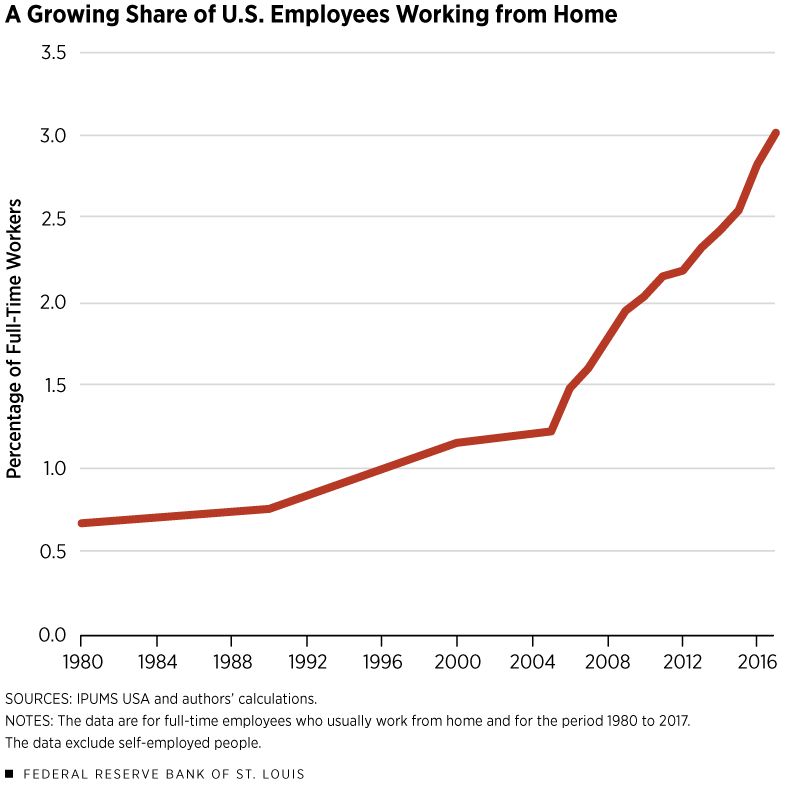What’s Driving the Growth in Telecommuting?

The following post is the first in a two-part series on the growth of telecommuting and what may be behind this growth.
An increasing number of Americans are escaping the frustration of rush-hour traffic by working from home. Though still a small slice of the U.S. labor force, telecommuters account for a growing share of the country’s workforce, according to a recent article in the Regional Economist.
Using data from the U.S. Census Bureau, Regional Economist Charles Gascon, former Research Intern Iris Arbogast and former Research Associate Andrew Spewak found that 3.4 million people in the U.S., or 3% of full-time employees, reported that they primarily worked from home in 2017.This number omits work done at nonresidential settings, such as coffee shops or coworking spaces, and is thus likely a lower bound on the actual number of employees who work outside the traditional workplace. Compare that with the roughly 500,000 people, or 0.7% of the workforce, who did so back in 1980.
The figure is even higher if one included employees who sometimes worked at home. Using data from the Federal Highway Administration’s 2017 National Household Travel Survey, the St. Louis Fed authors found that an additional 7% of full-time workers telecommuted four days or more per month.
The growth of those who primarily worked from home hasn’t been linear, however. As seen in the figure below, the share of these workers slowly increased until around 2005, after which growth accelerated.

“Technological advancement seems like the most obvious factor leading to the increased ability to work from home,” the authors wrote. “However, we at least must consider the possibility that other factors may also be at play.”
Drivers of Telecommuting
The authors found that the share of workers who telecommute in production occupations and construction and extraction occupations is the lowest across all occupational groups: about 1% each in 2017.
Since the 1980s, U.S. employment has been moving away from manufacturing and production jobs and toward service sector jobs. As such, a “shift in employment away from these and other jobs with a relatively low share of telecommuting would increase the overall telecommuting rate in the economy absent of any new technologies,” Gascon, Arbogast and Spewak wrote.
For example, 5% of workers in management, business and financial occupations and 4% of workers in sales and related occupations telecommuted in 2017, they noted.
The authors then did a shift-share analysis to see how much of the growth in telecommuting might be explained by the shift from jobs with a relatively low share of telecommuting to those with a relatively high share of telecommuting.
“We found that only about 2% of the growth in telecommuting since 1980 can be explained by occupational shifts,” they wrote. “Technological advancement likely explains the rest.”
The second blog post will examine where telecommuting is more prevalent and which workers are more likely to be telecommuters.
Notes and References
1 This number omits work done at nonresidential settings, such as coffee shops or coworking spaces, and is thus likely a lower bound on the actual number of employees who work outside the traditional workplace.
Additional Resources
- Regional Economist: Working from Home: More Americans Are Telecommuting
- On the Economy: How Much Does College Quality Matter?
- On the Economy: Economic Mobility: The Macroeconomy Matters
Citation
ldquoWhat’s Driving the Growth in Telecommuting?,rdquo St. Louis Fed On the Economy, Jan. 7, 2020.
This blog offers commentary, analysis and data from our economists and experts. Views expressed are not necessarily those of the St. Louis Fed or Federal Reserve System.
Email Us
All other blog-related questions

